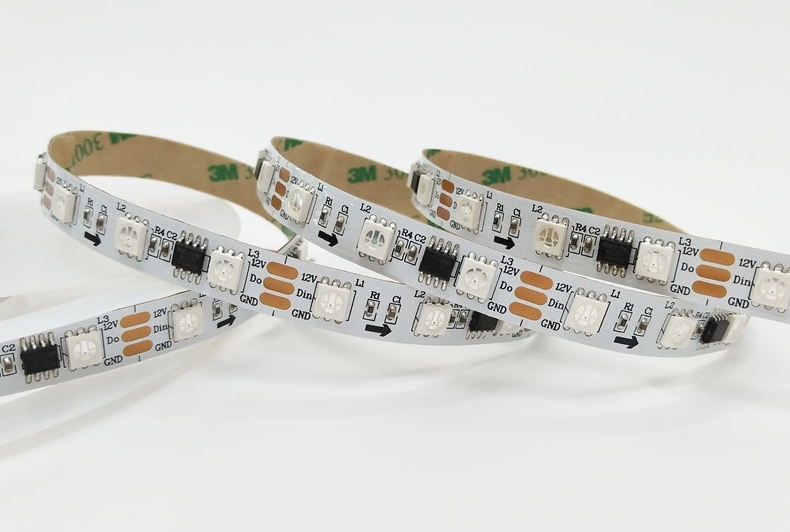1. Luminous flux
This is the first important parameter of all luminaires, and the standard definition is "the amount of radiation flux derived from the evaluation of the standard human visual properties of international regulations". For luminaires, this parameter is "the total amount of visible light emitted by the luminaire per unit time". Unit: lumen, symbol LM.
An addressable led strip is a good choice.
Other LED options: For lights of the same type, this parameter must exceed the minimum value (pit), as high as possible. (note that the LED can have serious dazzle light too bright, eyes will be uncomfortable) real parameter in determining the quality of lighting illumination - "accept the visible light flux on unit area", the limitation of working backward from the parameter limit luminous flux, is more complex, need to consider the types of light, the light distribution curve, installation environment, height and so on, the pit is not filled out. A rough reference value is given here for a standard incandescent lamp (no lampshade, standard light distribution), required to read and write (0.75 m distance approx. 300lx, 1.8 m diameter of effective illumination area), 900LM.
This IMPORTANT parameter is usually marked in an unimportant position, some small factories do not mark at all, so remember its unit symbol "LM", otherwise you will not recognize this parameter.
Second, the power
 This parameter lamp per hour consumption of electricity, this we all know, the smaller the better, not to say.
This parameter lamp per hour consumption of electricity, this we all know, the smaller the better, not to say.
Purchase advice: In the light flux to meet the needs of the case, the less power the better. (If the heat dissipation of high-power lamps is not handled well, it will seriously reduce the life of lamps) this parameter is generally marked, and sales staff also use him to distinguish the "brightness" of lamps. This parameter is second only in importance to light flux.
Third, color temperature
The definition is too complicated, omitted. The color temperature under natural light is directly given as a comparison.
Sunrise: 1900K. Midday sun: 5500K. Daylight 6500K in a clear noon sky. Incandescent lamp: 3000K
Purchasing advice: The color temperature of general LED lamps is better between 4000K-5000K. In the bedroom and other places that need emotion and comfort, choose 2700K-3000K.
LED lights with high color temperatures (above 5700K) look whiter, giving the illusion that the color temperature is "higher and brighter." The blue light of a high color LED lamp is more harmful. Light with low color temperature is yellowish, giving people a warm and comfortable feeling.
Four, color index Ra
We call the degree to which the light source presents the true color of the object the color rendering of the light source. The standard of measurement is the color rendering index. The higher the index, the less color distortion you see, and the specified color index of sunlight is 100.
Purchase advice: National standard daily use requirements Ra greater than 80. If you are engaged in color-related work, then the lamp must have a high color index requirement, then only choose incandescent lamps, even if other kinds of lamps can be 95 color index also do not buy (the reason is too long).
Five, life
The LIFE OF LAMPS AND LANTERNS HAS TWO PARTS ACTUALLY, TAKE TIME SHORTER AS THE LIFE OF WHOLE LAMP
1. Time required for the light flux of the whole lamp to decrease to 70% of the initial value
2, the whole lamp from the lighting to burn time
For LED fixtures, the second is much shorter than the first. The often claimed LED life of 5W-10W hours refers to the first life time, and the LED chip alone can be used for much longer under normal conditions. The second test is the manufacturer's LED driving ability and heat dissipation design ability.
Choose AND BUY OPINION: CHOOSE THE LAMPS AND LANTERNS OF RELIABLE BRAND manufacturer, THE NOMINAL LIFE IS LONGER THE BETTER. Note: Most leds have a life of 10 years, but the calculation is based on the fact that the life of the leds is Y hours/X hours of light per day =10 years. This "X hours of light per day" adds up to 10 years.
The national standard stipulates that the whole lamp life is greater than 25,000 hours (the calculation of this time is relatively circumvent, to a certain extent, the second item is omitted). The time declared by various manufacturers varies from 6000H to 25000H.
PS: The first term of traditional incandescent lamp (3000H) and fluorescent lamp (6000H) is much shorter than the second term, so many traditional lamps have reached the end of life (light flux is not qualified), but can still be lit, should be replaced in time.
Six, PF value
The PF value is the ratio of the actual power consumed by the luminaire to the apparent power. This is not the quality of the lamp parameter, only related to the grid load. Due to the low power consumption of LED lights, the impact is limited. However, some salespeople often claim that lamps with higher PF value will save power and have better quality, which is groundless.
Purchase advice: for small power (10W below) lamps and lanterns, do not have to consider this parameter. According to national regulations, PF of lamps and lanterns below 5W shall not be lower than 0.4, and PF of lamps and lanterns above 5W shall not be lower than 0.7.
7. Dimming performance
LED drivers can have a lot of playability, and there are many lamps on the market that claim to adjust brightness, color temperature, color, and more. All kinds of wifi, Bluetooth and other adjusted LED lamps are toys with 5-minute freshness, which cannot be used for lighting and are expensive, so it is not recommended to buy them. Traditional dimmer LED lamps, dimmer matching problem, are also not recommended to buy.